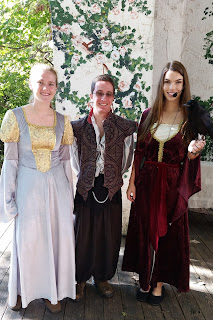If
you work in the Education Department at the World Bird Sanctuary then you will eventually
be a speaker at our education programs.
I have just recently started speaking these programs.
Barnaby the Barn Owl landing on my glove during an Amazing Animal Encounter (photo: Linda Wibbenmeyer)
How
do you prepare for this you may ask?
To begin with, I have been the handler in several Amazing Animal
Encounters (our weekend programs at the World Bird Sanctuary from Memorial Day
weekend to Labor Day weekend).
These programs are smaller than our full- length Raptor Awareness
programs, but they are a great way to learn about the birds we fly and
present. I learned several facts
and tips on presenting programs by listening to several Amazing Animal
Encounters speakers while presenting the birds in
these shows. There is also a basic
script that I was given to read over and learn my parts.
The
next step is to start small. I presented my first Birdday Party at the WBS Visitor’s Center. You present four different animals in a small setting. This was great practice and the kids at
the Birdday Party loved it (as did the adults)! It really helped to boost my confidence, too.
The "Royal Falconers" at K.C. Renfaire, Kelsey McCord, Matt Levin and Paige Davis (photo: B. J. Talley)
As we
come into fall the Renaissance Festival in Kansas City starts, and WBS presents
programs as the Royal Falconers Theater each
weekend. Cathy Spahn, a WBS
naturalist with many years’ experience, told me that on the second weekend she
wanted me to be the speaker for a few of the shows. These would be my first real presentations as a speaker.
These shows are only a half hour long though, so they are good “stepping stone”
programs. I was a little nervous
and a little excited.
I was
still a little nervous about getting the timing down right when Paige Davis
suggested I speak some of the same lines from our last Amazing Animal
Encounters. She suggested being
the speaker for a few birds in a show, rather than the whole show, with some flyers and some non-flyers, so that I could get
a feel for it and get some feedback from the other people helping in the
show. So the next day I received a
bit of coaching before the program started, and then spoke for three of our
birds.
I
learned during that first show that being the speaker is more than just
talking. You still have to
remember to move about the stage when flying the birds. I made sure to get that part right for
the second show. I received some great pointers after each of the programs to
improve my role as the speaker. I also felt much more ready for the following
weekend at the Renaissance Festival.
As
the day of my first full show began, Paige took the first show so that I could
listen to her and get a feel for this particular setting. At the Renaissance Faire we do four
shows each day, and this weekend we had three speakers. When my turn came up for the second
show I briefly went over what I should be saying with Paige and Matt Levin,
past WBS employee and current volunteer.
I took a deep breath and walked out on stage. I introduced each bird as they came out and spoke about each
of their species as they flew over the audience’s heads. After they fly, each bird is walked
between the aisles. The birds did
their part wonderfully which helped me to stay focused. I introduced our last bird in the show
(a Bald Eagle), then explained how the audience could hand their cash donations
to our American Crow, Aesop, and the audience applauded! I checked the clock,
and my timing was perfect! I had survived!!
After
the program I got a few more tips and pointers, and I presented two more shows
the following day.
Shadow, a beautiful Bateleur Eagle, was a new bird for me to handle (photo: Paige Davis)
About
a week later, Paige and I presented three full Raptor Awareness programs at a
campground for fifth graders. This
time it was a full length Raptor Awareness program which runs 45 to 50 minutes. In these 3 shows we also had a bird that I had never met, let alone spoken about. We brought Shadow, the Bateleur Eagle,
for our finale. Paige spoke the
first two programs so that I could learn all about Shadow as a bird and a
species. The final program started and I introduced our first bird. The program went great, and the kids
loved it! I got it to 47 minutes
and then another few minutes for questions. Perfect! It was
my best program to date.
I
look forward to speaking many more programs and learning about more of our
birds as I continue to work for the World Bird Sanctuary.
Submitted
by Kelsey McCord, World Bird Sanctuary Naturalist













































